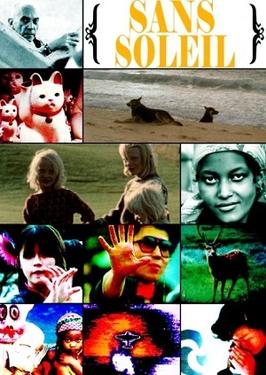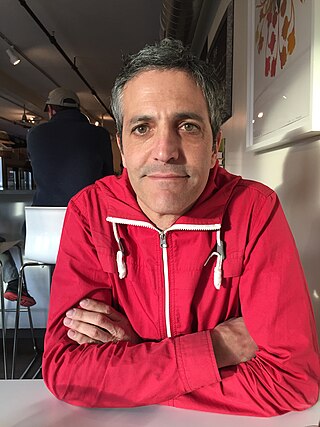Related Research Articles

A documentary film or documentary is a non-fictional motion picture intended to "document reality, primarily for instruction, education or maintaining a historical record". Bill Nichols has characterized the documentary in terms of "a filmmaking practice, a cinematic tradition, and mode of audience reception [that remains] a practice without clear boundaries".

Marlon Troy Riggs was a black gay filmmaker, educator, poet, and activist. He produced, wrote, and directed several documentary films, including Ethnic Notions, Tongues Untied, Color Adjustment, and Black Is...Black Ain't. His films examine past and present representations of race and sexuality in the United States. The Marlon Riggs Collection is open to the public at Stanford University Libraries.

Television documentaries are televised media productions that screen documentaries. Television documentaries exist either as a television documentary series or as a television documentary film.

Mark Rappaport is an American independent/underground film director and film critic, who has been working since the 1960s.

Tongues Untied is a 1989 American video essay experimental documentary film directed by Marlon T. Riggs, and featuring Riggs, Essex Hemphill and Brian Freeman. The film seeks, in its author's words to, "...shatter the nation's brutalizing silence on matters of sexual and racial difference."
Passion Pictures is a British film production company established by Andrew Ruhemann in 1987. The company has studios in London, Melbourne, Paris, Toronto, and New York City.

Sans Soleil is a 1983 French documentary film directed by Chris Marker. It is a meditation on the nature of human memory, showing the inability to recall the context and nuances of memory, and how, as a result, the perception of personal and global histories is affected. The title Sans Soleil is from the song cycle Sunless by Modest Mussorgsky, a brief fragment of which features in the film. Sans Soleil is composed of stock footage, clips from Japanese movies and shows, excerpts from other films as well as documentary footage shot by Marker.
Jason Mittell is a professor of American studies and film and media culture at Middlebury College whose research interests include the history of television, media, culture, new media, and digital humanities. He is author of four books, Genre and Television (2004), Television and American Culture (2009), Complex TV: The Poetics of Contemporary Television Storytelling, and Narrative Theory and Adaptation. He also co-edited How To Watch Television and co-authored The Videographic Essay: Practice and Pedagogy. His digital-humanities activities focus primarily on videographic media criticism and, in 2015, he co-founded the first "Scholarship in Sound & Image" workshop, supported by a grant from the National Endowment for the Humanities. Moreover, he is journal manager and co-editor of [in]Transition: Journal of Videographic Film & Moving Studies, published by the Open Library of Humanities and supported by the Society for Cinema and Media Studies.
From the Journals of Jean Seberg is a 1995 video essay on the life of actress Jean Seberg. It is directed by film essayist Mark Rappaport.

Sam Green is an American documentary filmmaker. His most recent projects are “live documentaries” in which he narrates a film in-person while musicians perform a live soundtrack. His 2018 project A Thousand Thoughts features a live score by the Kronos Quartet, and his 2012 project The Love Song of R. Buckminster Fuller featured a live score by the band Yo La Tengo. Green's 2004 film The Weather Underground was nominated for an Academy Award, included in the Whitney Biennial, and broadcast nationally on PBS.

Thomas Allen Harris is a critically acclaimed, interdisciplinary artist who explores family, identity, and spirituality in a participatory practice. Since 1990, Harris has remixed archives from multiple origins throughout his work, challenging hierarchy within historical narratives through the use of pioneering documentary and research methodologies that center vernacular image and collaboration. He is currently working on a new television show, Family Pictures USA, which takes a radical look at neighborhoods and cities of the United States through the lens of family photographs, collaborative performances, and personal testimony sourced from their communities..

Lynne Sachs is an American experimental filmmaker and poet living in Brooklyn, New York. Her moving image work ranges from documentaries, to essay films, to experimental shorts, to hybrid live performances. Working from a feminist perspective, Sachs weaves together social criticism with personal subjectivity. Her films embrace a radical use of archives, performance and intricate sound work. Between 2013 and 2020, she collaborated with musician and sound artist Stephen Vitiello on five films.

Mark Cousins is an English-born, Northern Irish director and writer. A prolific documentarian, among his best-known works is the 15-hour 2011 documentary The Story of Film: An Odyssey.
Ethnic Notions is a 1987 documentary film directed by Marlon Riggs. It examines anti-Black stereotypes that permeated popular culture from the ante-bellum period until the advent of the Civil Rights Movement of the 1960s.

Sleep Has Her House is a 2017 experimental film shot, written, produced, directed, and edited by Welsh filmmaker, Scott Barley. Like several of his previous short films, the film also was shot on a Camera phone, iPhone 6. It also features still photography and hand drawn images by the artist.

Kogonada is a South Korean-born American filmmaker. He is known for his video essays that analyze the content, form and structure of various films and television series. The essays frequently use narration and editing as lenses, and often highlight a director's aesthetic. Kogonada—the name is a pseudonym—is a regular contributor to Sight & Sound, and is frequently commissioned by The Criterion Collection to create supplemental videos for its home-video releases. He has also written, directed and edited the feature films Columbus (2017) and After Yang (2021).
Every Frame a Painting is a series of 28 video essays about film form, film editing, and cinematography created by Taylor Ramos and Tony Zhou between 2014 and 2016. They were first published on YouTube but have also been released on Vimeo.
A still image film, also called a picture movie, is a film that consists primarily or entirely of still images rather than consecutive still images in succession, forgoing the illusion of motion either for aesthetic or practical reasons. These films usually include a standard soundtrack, similar to what is found in typical sound films, complete with music, sound effects, dialogue or narration. They may also use various editing techniques found in traditional films, such as dissolves, zooms, and panning.

Voir is an American television series featuring video essays about cinema. It was produced by Academy Award-nominated director David Fincher and released on Netflix.
David Prior is an American film director, screenwriter, producer, and editor best known for his work on the cult horror film The Empty Man, and television series such as Voir and Guillermo del Toro's Cabinet of Curiosities. He has also directed and produced making-of documentaries for films, most notably the works of David Fincher and Michael Bay.
References
- ↑ "WATCH: Best Film Video Essays of 2020". StudioBinder. 27 December 2020. Retrieved 21 October 2023.
- ↑ McLaughlan, Paul. "LibGuides: How to do a Video Essay: Home". ecu.au.libguides.com. Retrieved 25 October 2023.
- ↑ "Video Essays". Excelsior OWL. Retrieved 25 October 2023.
- ↑ Bernstein, Paula (3 May 2016). "What is a Video Essay? Creators Grapple with a Definition". Filmmaker Magazine . Retrieved 5 July 2017.
- 1 2 Naremore, James; Hanstke, Tamar (18 June 2023). "A Short Interview with Dr. James Naremore". Cinephile: The University of British Columbia's Film Journal. 17 (1): 5–7. doi:10.14288/cinephile.v17i1.198233.
- ↑ Higgin, Tanner (23 January 2018). "Why and How to Use YouTube Video Essays in Your Classroom". Common Sense Education. Retrieved 25 March 2018.
- ↑ Roose, Kevin (8 June 2019). "The Making of a YouTube Radical". The New York Times. ISSN 0362-4331 . Retrieved 19 October 2023.
- ↑ Ibraheem, Azeezah (13 March 2023). "The Growing Popularity of Video Essays". Study Breaks. Near East University. Retrieved 26 October 2023.
- ↑ Laura Rascaroli (2008). "The Essay Film: Problems, Definitions, Textual Commitments". Framework: The Journal of Cinema and Media. 49 (2): 24–47. doi:10.1353/frm.0.0019. ISSN 1559-7989. S2CID 170942901.
- 1 2 Cinematic Essay Film Genre Archived 2007-08-08 at the Wayback Machine . chicagomediaworks.com. Retrieved March 22, 2011.
- ↑ (registration required) Lim, Dennis (July 31, 2012). "Chris Marker, 91, Pioneer of the Essay Film" Archived 2012-08-03 at the Wayback Machine . The New York Times . Retrieved July 31, 2012.
- ↑ Discussion of film essays Archived 2007-08-08 at the Wayback Machine . Chicago Media Works.
- ↑ Gray, David Winks (30 January 2009). "The essay film in action". San Francisco Film Society. Archived from the original on 15 March 2009.
- ↑ Brown, Bill, ed. (Spring 2009). "Talking Pictures: The Art of the Essay Film". Cinematheque. UW–Madison. Archived from the original on 20 July 2011. Retrieved 22 March 2011.
- ↑ Bresland, John. "On the Origin of the Video Essay". Blackbird: an online journal of literature and the arts. Department of English at Virginia Commonwealth University & New Virginia Review, Inc. ISSN 1540-3068 . Retrieved 5 July 2017.
- ↑ Stream It or Skip It: 'Voir' On Netflix - Decider
- ↑ Netflix's Visual Essay Series Voir is Worth a Look|TV/Streaming|Roger Ebert
- 1 2 3 18 Great Essays from 2018 - Thomas Flight
- ↑ Liptak, Andrew (1 August 2016). "This filmmaker deep-dives into what makes your favorite cartoons tick". The Verge . Retrieved 5 July 2017.
- ↑ Oller, Jacob (14 December 2017). "The 17 Best Video Essays of 2017". Film School Rejects . Retrieved 24 December 2020.
- ↑ Shields, Meg (13 December 2018). "The Best Video Essays of 2018". Film School Rejects . Retrieved 24 December 2020.
- 1 2 3 4 Lee, Kevin B.; Verdeure, David (10 January 2010). "The best video essays of 2017". British Film Institute . Retrieved 24 December 2020.
- ↑ Netflix explores the visual essay’s potential with the David Fincher-produced Voir|A.V.Club
- ↑ Netflix cruelly announces David Fincher-produced video essay series, not a new season of Mindhunter|A.V. Club
- ↑ Raftery, Brian (8 March 2019). "How YouTube Made a Star Out of This Super-Smart Film Critic". Wired. Conde Nast. Retrieved 17 March 2024.
- ↑ "Kevin B. Lee". British Film Institute. Retrieved 1 February 2021.
- ↑ The Signifyin’ Works of Marlon Riggs: Positive Images|Current|The Criterion Collection
- ↑ Deeper into Movies: The Video Essays of Mark Rappaport|ACMI: Your museum of screen culture
- ↑ Video Essay: Mark Rappaport on The Empty Screen - Talkhouse
- ↑ Image and Voice:The Audiovisual Essays of Mark Rappaport - Film Critic: Adrian Martin
- 1 2 Avissar, Ariel; DiGravio, Will; Lee, Grace (14 January 2020). "The best video essays of 2019". British Film Institute . Retrieved 4 September 2020.
- ↑ Avissar, Ariel; Harris, Cydnii Wilde; Lee, Grace (18 January 2022). "The best video essays of 2021". British Film Institute . Retrieved 18 June 2022.
- ↑ Harris, Cydnii Wilde (13 August 2020). "Video Essays That Address Race, Inequality, and the Movement for Black Lives". Hyperallergic. Retrieved 1 February 2021.
- ↑ "Seen and Heard: Selections from the Black Lives Matter Video Essay Playlist". Open City Documentary Festival. Retrieved 1 February 2021.
- ↑ Brief Descriptions and Expanded Essays of Titles at National Film Registry
- ↑ No Regrets: A Celebration of Marlon Briggs|BAMPFA
- 1 2 REFRAMED NO. 14: MARK RAPPAPORT & THE VIDEO ESSAY|PopMatters
- ↑ TARGET AUDIENCES: THE FILMS OF MARLON RIGGS - Artfourm
- ↑ Red Hollywood|Screen Slate
- ↑ Red Hollywood - Harvard Film Archives
- ↑ 'Red Hollywood' Looks at Work by Blacklisted Filmmakers - The New York Times
- ↑ Writing Desire|Video Data Bank
- ↑ Essay Film Festival: Los Angeles Plays Itself|Institute of Contemporary Arts
- ↑ Los Angeles Plays Itself - LUX
- ↑ Revisiting Thom Andersen’s ‘Los Angeles Plays Itself’ and Three New Movies for the Remake - Film Independent
- ↑ Kirbach, Benjamin (2014). "Critical Psychosis: Genre, Détournement, and Critique in Mr. Plinkett's Star Wars Reviews". Iowa Journal of Cultural Studies. 16 (1): 109. doi: 10.17077/2168-569X.1430 .
- ↑ Video Essay: Sirk/Anti-Sirk on Notebook|MUBI
- ↑ FILMADRID & MUBI: The Video Essay—"News from Taxi Driver" on Notebook|MUBI
- ↑ The 20 Best Video Essays of 2020 - Film School Rejects
- ↑ The best video essays of 2020 - Polygon
- 1 2 The best video essays of 2021|Sight & Sound
- 1 2 3 The best video essays of 2022|Sight & Sound
- ↑ The best video essays of 2023|BFI
- ↑ Martin, Michel (13 February 2022). "Cryptocurrency expert slams NFT hype". NPR . Retrieved 28 May 2022.
- ↑ The Video Essay: "Sound & Sight & Time" on Notebook|MUBI
- ↑ D’Cruz, Glenn (2021). "3 or 4 things I know about the audiovisual essay, or the pedagogical perils of constructive alignment". Media Practice and Education. 22 (1): 61–72 – via Taylor & Francis Online.
- ↑ Evans, Christine (Spring 2022). "The Sharpening of Knives: Video Essays and Reflecting on Argumentation". The Journal of Cinema and Media Studies. 61 (8). doi:10.3998/jcms.18261332.0061.803. ISSN 0009-7101.
- ↑ Nieminen, Juuso Henrik; Tuohilampi, Laura (2 October 2020). "'Finally studying for myself' – examining student agency in summative and formative self-assessment models". Assessment & Evaluation in Higher Education. 45 (7): 1031–1045. doi:10.1080/02602938.2020.1720595. ISSN 0260-2938.
- ↑ "About [in]Transition | [in]Transition". mediacommons.org. Retrieved 23 October 2023.
- ↑ "Scholarship in Sound & Image". Scholarship in Sound & Image. Retrieved 25 October 2023.